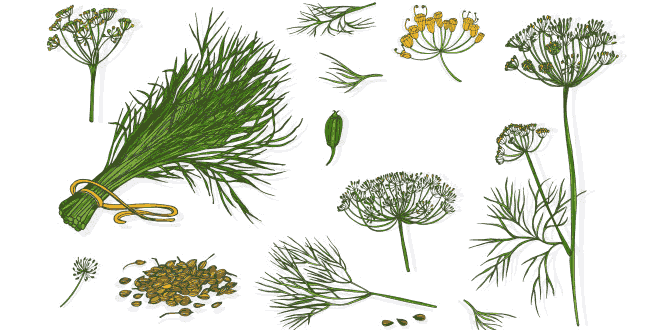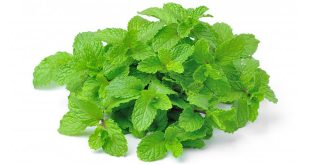| Kingdom: | Plantae |
| Family: | Apiaceae |
| Order: | Apiales |
| Genus: | Anethum |
| Tribe: | Apieae |
Dill Annual Herb — Dill (Anethum graveolens) is a short-lived annual herb. It is the sole species of the genus Anethum, though classified by some botanists in the related genus Peucedanum as Peucedanum graveolens (L.) C.B. Clarke.
It grows to 40-60 cm tall, with slender stems and alternate, finely divided, softly delicate leaves 10-20 cm long. The ultimate leaf divisions are 1-2 mm broad, slightly broader than the similar leaves of fennel, which are threadlike, less than 1 mm broad, but harder in texture. The flowers are white to yellow, in small umbels 2-9 cm diameter. The seeds are 4-5 mm long and 1 mm thick, and straight to slightly curved with a longitudinally ridged surface.
Its seeds, dill seed are used as a spice, and its fresh leaves, dill, and its dried leaves, dill weed, are used as herbs.
Fresh and dried dill leaves (sometimes called “dill weed” to distinguish it from dill seed) are used as herbs.
Like caraway, its fernlike leaves are aromatic, and are used to flavor many foods, such as gravlax (cured salmon), borscht and other soups, and pickles (where sometimes the dill flower is used). Dill is said to be best when used fresh, as it loses its flavor rapidly if dried; however, freeze-dried dill leaves preserve their flavor relatively well for a few months.
In the Middle Ages, dill was thought to protect against witchcraft.
Dill seed is used as a spice, with a flavor similar to caraway.
Dill oil can be extracted from the leaves, stems and seeds of the plant.
Dill: Annual Herb Encyclopedia
Dill (Anethum graveolens) is an annual herb in the celery family Apiaceae. It is the only species in the genus Anethum. Dill is grown widely in Eurasia, where its leaves and seeds are used as a herb or spice for flavoring food.
Dill grows up to 40–60 cm (16–24 in), with slender hollow stems and alternate, finely divided, softly delicate leaves 10–20 cm (4–8 in) long. The ultimate leaf divisions are 1–2 mm (0.04–0.08 in) broad, slightly broader than the similar leaves of fennel, which are threadlike, less than 1 mm (0.04 in) broad, but harder in texture. The flowers are white to yellow, in small umbels 2–9 cm (0.8–3.5 in) diameter. The seeds are 4–5 mm (0.16–0.20 in) long and 1 mm (0.04 in) thick, and straight to slightly curved with a longitudinally ridged surface.
Dill has been found in the tomb of Egyptian Pharaoh Amenhotep II, dating to around 1400 BC. It was also later found in the Greek city of Samos, around the 7th century BC, and mentioned in the writings of Theophrastus (371–287 BC).
 Kids Portal For Parents India Kids Network
Kids Portal For Parents India Kids Network







